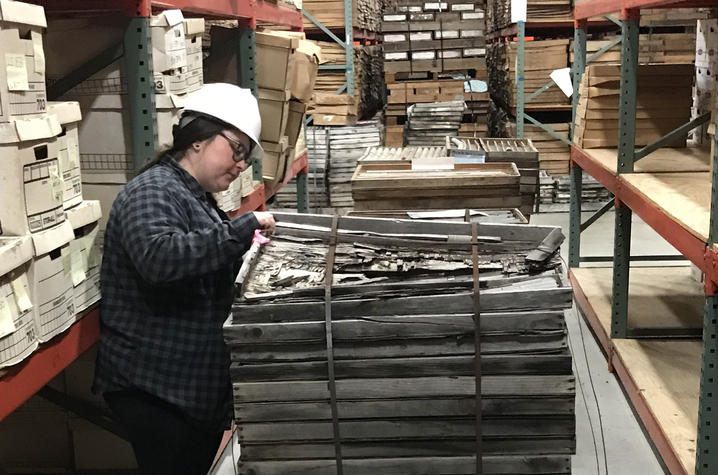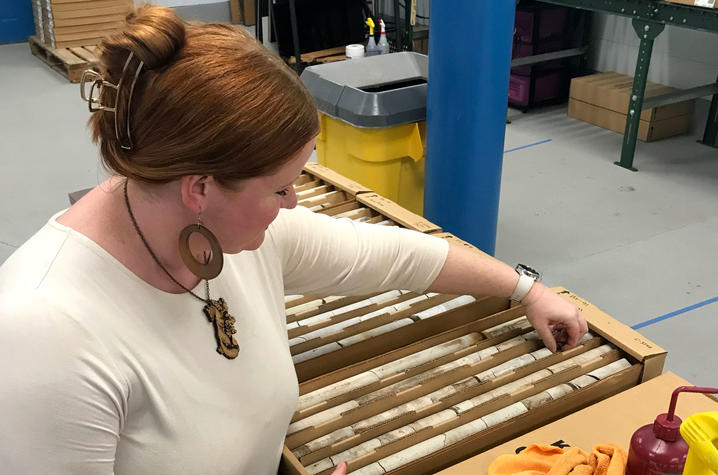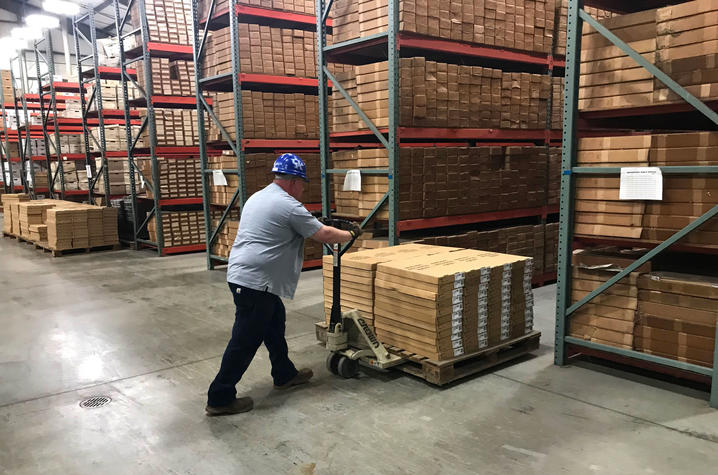KGS receives national funding to preserve Kentucky’s critical mineral collections
LEXINGTON, Ky. (June 21, 2023) — The Kentucky Geological Survey (KGS), will preserve and increase access to mineral cores from western and south-central Kentucky through Save America’s Treasures, a National Park Service grant program in collaboration with the Institute of Museum and Library Services.
The grant activity is based at the KGS Earth Analysis Research Library (EARL) and will play a vital role in research, with national security implications, on critical minerals in Kentucky.
EARL, which preserves geological information and facilitates research for the benefit of Kentucky, houses an extensive collection of rock cores — cylindrical samples of rock obtained while drilling boreholes for oil, gas, water, and mineral exploration as well as engineering investigations.
The grant focuses on a collection of 170 rock cores, that would extend more than 24 miles if laid end-to-end, from the Western Kentucky Fluorspar and south-central minerals districts. The cores were obtained and donated to EARL in the 1970s. Fluorspar is used directly or indirectly to manufacture products such as aluminum, gasoline, insulating foams, refrigerants, steel, and uranium fuel.
Elizabeth Adams, principal investigator on the grant, is the archives manager and research coordinator at EARL. She has led the effort to continue organizing and modernizing EARL operations since 2018. Her goal: to see the KGS rock core collection preserved, made digitally accessible to the public, and to provide value to the research and education communities.
The Save America’s Treasures grant funds a five-person team: two geologists, two archivists, and one geological photographer to protect, record, and analyze the core collection. According to Adams, over the last two to three years there has been an influx of requests for these cores due to a sudden renewed interest in, and federal funding for, critical minerals research. The Department of the Interior, the Department of Energy, the United States Geological Survey, and others are now offering funding to identify areas for undiscovered deposits that could reduce U.S. import dependence and diversify supply chains for critical minerals.
KGS Director and State Geologist William Haneberg said, “This project aligns with both the EARL’s growing role as a world-class research repository and the wealth of critical mineral and rare earth element (REE) expertise within KGS, the Earth and Environmental Sciences Department, the Mining Engineering Department, and the Center for Applied Energy Research at UK. Our long-term goal is to support research at UK and elsewhere that will allow the United States to develop secure supplies of minerals essential for both national security and a low-carbon energy future.”
Since 2019, KGS researchers have received eight externally funded projects focused on critical mineral and REE exploration.
- 2019: KGS along with the UK Department of Mining Engineering and the UK Center for Applied Energy Research explored the REE contents of coal seams, rocks associated with coal seams, power plant ash, and other potential sources of REEs in Kentucky.
- 2020 – 2022: KGS collected approximately 50 Devonian shale phosphate-rich core and outcrop samples to help establish an understanding of regional REE concentration gradients for phosphorites.
- 2022: In December, KGS completed phase one of the Hicks Dome Regional Earth MRI Priority Project wherein KGS reviewed, inventoried and organized a robust archive of mineral information documents and specimens related to the Western Kentucky Fluorspar District.
- 2023: In early 2023, KGS completed phase two of the Hicks Dome project. KGS collected additional samples for geochemical analysis and performed petrographic classification. Researchers created a digital 3D geologic model of the fluorspar district and documented practitioner-level procedures and guidelines for subsurface geological modeling.
- 2023: By this June, KGS will complete an Earth MRI geochemistry of Pennsylvanian underclays project which involves sampling two Kentucky cores and submitting 93 samples to U.S. Geological Survey for REE geochemical analysis.
- 2023: KGS began collecting and testing Pennsylvanian black shale samples from exploration drill cores and active underground mines to better determine the composition of the shales and their potential as sources of critical and strategic elements.
- 2023: KGS began studying the overlapping critical mineral systems in south-central Kentucky and north-central Tennessee.
- 2023: KGS completed an Earth MRI project of geochemical analysis of Devonian black shales for critical elements.
Anticipating the continued need for critical minerals in our society, KGS is currently evaluating several other grants and projects involving rock cores and REE.
Once the Save America's Treasures grant work is complete, and in support of the land-grant mission of the University of Kentucky, the core collection and data will be digitally accessible to all interested parties via the KGS website. “This collection of cores is an incredible geologic resource of great scientific value,” said Adams. “Preservation and curation by EARL ensures that the cores are available for future research not only by the Kentucky geologic community, but also the national and international science communities.”
This project was made possible by the Institute of Museum and Library Services Award Number ST-252530-OMS-2.
As the state’s flagship, land-grant institution, the University of Kentucky exists to advance the Commonwealth. We do that by preparing the next generation of leaders — placing students at the heart of everything we do — and transforming the lives of Kentuckians through education, research and creative work, service and health care. We pride ourselves on being a catalyst for breakthroughs and a force for healing, a place where ingenuity unfolds. It's all made possible by our people — visionaries, disruptors and pioneers — who make up 200 academic programs, a $476.5 million research and development enterprise and a world-class medical center, all on one campus.







